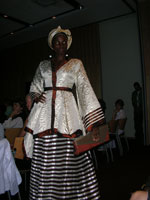Wrapped in thought at Fashion Indaba
 'Has clothing in South Africa got us thinking', was the title of the first presentation of the Fashion Indaba stream of the DI9 conference currently on in full swing in Cape Town. "Do the clothes we wear reflect our thoughts, are we letting people into our minds via what we wear without even knowing it?" asks Durban-based designer Amanda Laird Cherry.
'Has clothing in South Africa got us thinking', was the title of the first presentation of the Fashion Indaba stream of the DI9 conference currently on in full swing in Cape Town. "Do the clothes we wear reflect our thoughts, are we letting people into our minds via what we wear without even knowing it?" asks Durban-based designer Amanda Laird Cherry. Immersed, in not just the aesthetic and style, but also the relevance of Zulu and other traditional clothing, Laird Cherry wraps, swaths, robes and swaddles in her designs, revealing more - ironically - than the possible origins of umplacelo pants, the archetypes of how people wrap blankets, a shared heritage of the sound, smell and motifs of sheshwe, the superstitions around Njete fabric, a respect for the significance of overalls. But about the issue of whether we reveal or conceal our true selves to each other via our clothing, I leave it to you, to debate amongst yourselves.
Immersed, in not just the aesthetic and style, but also the relevance of Zulu and other traditional clothing, Laird Cherry wraps, swaths, robes and swaddles in her designs, revealing more - ironically - than the possible origins of umplacelo pants, the archetypes of how people wrap blankets, a shared heritage of the sound, smell and motifs of sheshwe, the superstitions around Njete fabric, a respect for the significance of overalls. But about the issue of whether we reveal or conceal our true selves to each other via our clothing, I leave it to you, to debate amongst yourselves.
 The claim to fame of visiting UK designer, Karen Welman, are her ranges of baby clothes made from a safety material developed by NASA to prevent overheating. It's adorable, it's sensible and reveals a design ethic of real empathy and concern for the comfort of the user. This is also demonstrated in the attention to detail of their range of clothing for disabled teenagers, enabling them to look just like other kids, but including features like magnetic buttons, panels that can be zip fastened while sitting down, LED lights and the signature temperature regulation fabrics.
The claim to fame of visiting UK designer, Karen Welman, are her ranges of baby clothes made from a safety material developed by NASA to prevent overheating. It's adorable, it's sensible and reveals a design ethic of real empathy and concern for the comfort of the user. This is also demonstrated in the attention to detail of their range of clothing for disabled teenagers, enabling them to look just like other kids, but including features like magnetic buttons, panels that can be zip fastened while sitting down, LED lights and the signature temperature regulation fabrics.
Passion blasted through the Fashion Indaba again in the next session, in the form of Thando Mangalosi, the dynamic founder of the acclaimed Sun Goddess brand. The name was inspired by spiritual leader Credo Mutwa - in the form of a vision... of an Africa at a time when there was enough... of African Kings and Queens... Gods and Goddesses. The logo of a circle over a double circle with a cross through it is the symbol for immortality. Savvy manipulation of the media and a deep understanding of the value that African culture can impart to the world, keeps the fires burning.
 Mangalosi accurately identifies the necessity of an Afro-centric approach as a counter to being copied. This is the strategy that is allowing them to expand into swimwear - featuring modest cuts that don't reveal too much, suede bustiers for the beach - to die for, doll, as well as their own range of sunglasses. A children's range is also in the pipeline. He describes his team as "a small tribe" and informed us that with them behind him, he could 'go to war with anybody'. Fashion as a new kind of cultural weapon?
Mangalosi accurately identifies the necessity of an Afro-centric approach as a counter to being copied. This is the strategy that is allowing them to expand into swimwear - featuring modest cuts that don't reveal too much, suede bustiers for the beach - to die for, doll, as well as their own range of sunglasses. A children's range is also in the pipeline. He describes his team as "a small tribe" and informed us that with them behind him, he could 'go to war with anybody'. Fashion as a new kind of cultural weapon?
Emotions were running high, as you can imagine, when fashion historian Dr Valerie Steele, Museum Director of the Fashion Institute of Technology in New York, took to the podium to contextualise the themes of fashion and globalisiation. Giving a potted perspective of a good few hundred years of the politics of fashion trends, she points out that fashion 'is neither a whirligig of pointless change, nor a mirror that reflects historical events, it is a part of history and has its own history'. Interestingly, the economic power centres of the world have also, historically seen fashion as central to their economies. Are international designers such as John Galliano and Christian LaCroix, who appropriate African styles, just ripping us off and losing original cultural meaning, or is that there is deeper significance at play? Perhaps it will be via the forthcoming fashion exhibit which Steele is curating for the Museum of African Art in New York in 2007, that we will be able to really gauge the significance of our own myths in the global fashion psyche. Bring it on...






















